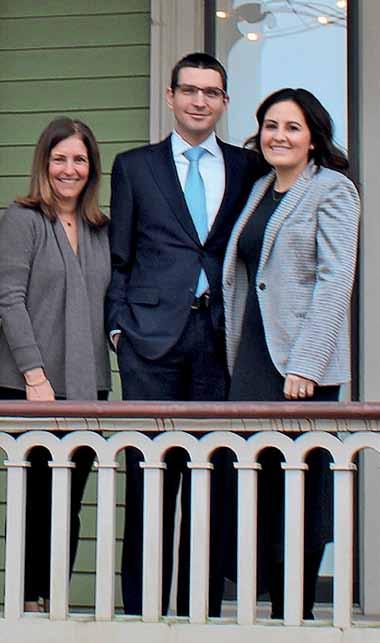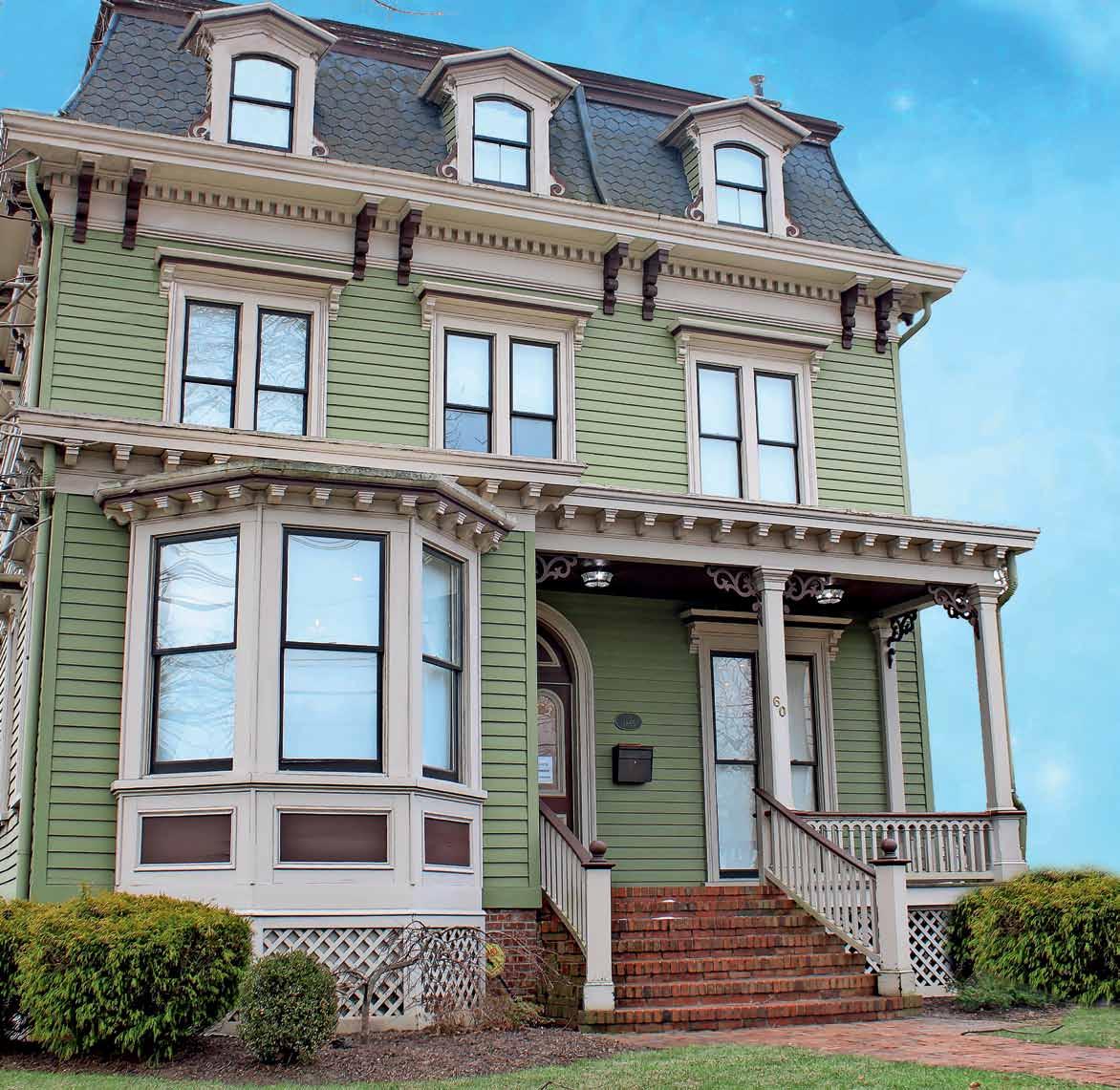
17 minute read
Real Talk
You Never Forget Real Talk
Your First Time
very real estate deal is unique. Some are certainly more memorable than others, naturally, as each buyer and bidding war, each seller and situs, each neighborhood and negotiation, brings something unique to the table.
Yet there is something truly special about that very first deal that makes it unforgettable. With a mix of life-changing moments, career-informing lessons and emotional rides, our gathering of Long Island real estate professionals look back and share stories of their first time.
Kevin Leatherman
Leatherman Homes It was at The Parker Deauville, in Long Beach. I was the board president and sold one of my neighbor’s units during a very slow market. I had a warm emotionally soaring feeling on scoring on my first deal with a buyer that truly appreciated my hard work and efforts in helping them. For the first time in my professional life, everything just clicked! I felt like I had arrived! I knew before the closing that real estate was my true calling. Soon after, I quit my full-time job as a Wall Street trader and opened my own agency. I went for loving what I do for a living over just making as much money as possible, and I never looked back.
Elizabeth Markovic
Compass Real Estate The first time I must say, I was a little nervous, mainly because I didn’t want anything to go wrong. I feel that I was lucky, as my buyer was really a pleasure to work with, along with the listing agent. It was interesting to see how comfortable both the buyer and seller were at the closing table, which created a very pleasant atmosphere.
Home Experts
Compass Real Estate I will never forget my first deal! I got my buyer a home in Nassau County. The buyers and sellers signed the contract—a reason to celebrate for all parties. A few weeks later it was revealed that my buyer had a co-op to sell in Queens. Being so new to the industry, I never asked if they had something to sell. I thought the listing agent was going to. Well, the buyer sold the co-op in a week, so all was okay. Five years later, they sold the house and bought one on the North Shore—I was the realtor on all transactions!
Ray Pearson
Cobbleridge Realty Corp. I originally came from the mortgage side of the business, so we didn’t have the opportunity to meet anyone. It was just numbers and paperwork faxed to our office. Yawn. I never got the privilege to see how we were changing people’s lives for the better. I always loved the direct interaction with individuals and hearing their stories, so I made the move to real estate. It was exhilarating, to say the least. I knew nothing about the business back then, but what I did know was I was directly responsible for the next chapter in families lives. When you have a grown man who says, with tears in his eyes, “Thank you, we never thought we would ever own a home”—he then proceeded to give me a hug—I was hooked on this passion, which just happens to allow me to bring families to their next journey in life.
Dee Dee Brix
Berkshire Hathaway Home Services — Laffey International Realty I have vivid memories of my first sale. It was in 1995 and I was at a seminar and went to the pay phone to call my client—she told me she would sell the house for $263,000 if my customers would meet that counter offer. They did! And when I called the owner back to tell her they met her counter, she burst into tears—she had lived in that house for 40 years and the reality hit her. Then I cried along with her. Buyers and seller were very happy to make their move!
Compass Real Estate The first real estate transaction was the sale of my neighbor’s home! It was a bittersweet event, as I was extremely happy to have sold my first home, setting a sales record in my area, but on the other hand I was extremely sad that I was losing one of my best friends, as they were moving out of town.
Donna O’Reilly Einemann
Douglas Elliman My very first sale was a buyer I met at an open house in Hewlett that I was doing for the listing agent. The buyer didn’t purchase that house, however—I showed her another house that she did purchase in Lynbrook. We closed on the home in December 2005, seven months after I got my real estate license. I was so excited! I was working a fulltime job and working real estate nights and weekends, so my focus was primarily working with buyers, because that was when they were available.
This house was a 1947 expanded Cape with a large kitchen that opened up to a sizable family room. I can still picture it today. I learned so much handling this sale, especially at the home inspection. I must have asked the inspector 1,000 questions! That’s where I learned that 100 amps of electric was the minimum a home could have in order to get financing. This house only had 60 amps...yikes! But we negotiated successfully and closed the deal with the mentorship of the listing agent whose open house I did. Great teamwork!
I’m happy to say that the buyer still resides in that home today. I’m sure with 200 amp electric by now!
NICK COLOMBOS
Compass Real Estate My very first deal in real estate was a rental on Allen Street off of Canal in NYC. I was working as a new agent with Sopher Real Estate and received a cold call from the front desk to show this dilapidated prewar rental building to a prospective renter. I think the manager had nobody else to give the call to.
We arrive at the building only to find a drunk super in the main lobby with the keys to the walk-up apartment. We walk up seven flights in the afternoon July heat, enter the two-bedroom railroad apartment with tub and toilet in the kitchen, and find two mice chasing each other from one side of the apartment to the other. I was shocked and jumped on the kitchen counter while the prospective buyers stood there motionless.
I remember feeling that this deal was not going to happen, but was surprised they still wanted the apartment and signed a lease. Excellence


“A room without books is like a body without a soul. — Marcus Tullius Cicero“
Wish You Had The Perks Wish You Had The Perks Of Having Your Own Of Having Your Own Concierge Service? Concierge Service? Now YOU CAN.Now YOU CAN.
Give yourself, a relative or friend the gift of timeGive yourself, a relative or friend the gift of time with Apex Concierge Services, delivering top-tier,with Apex Concierge Services, delivering top-tier, white glove concierge services to clientele on Long Island white glove concierge services to clientele on Long Island and the New York City area. and the New York City area.
Our services:Our services:
Private Chef Private Chef Nutritionist Nutritionist In-Home Beauty & Wellness In-Home Beauty & Wellness Treatments Treatments Salon & Spa Services Salon & Spa Services Massage Therapist Massage Therapist At Home Yoga At Home Yoga Event PlanningEvent Planning Luxury Car Rentals Luxury Car Rentals Personal Chauffeur Personal Chauffeur Private Jet & Yacht Rentals Private Jet & Yacht Rentals Private Duty Nursing Private Duty Nursing Live-in Personal Assistants / Live-in Personal Assistants / Companions Companions Patient Sitters for Hospital / Patient Sitters for Hospital / Hospice Hospice Nanny Services Nanny Services House Cleaning and more...House Cleaning and more...
If the service you need isn’t on this list, give us a call.If the service you need isn’t on this list, give us a call. We’ll create a custom package We’ll create a custom package to fit your individual needs.to fit your individual needs.





24-hour concierge services24-hour concierge servic available 365 days es available 365 daya ys aear! year!
Options for excluOptions for esive membership or single-service nexclusive membership or single-serviceeds.needs. We also offer Apex Concierge Services as a Corporate Employee Benefit or an We also offer Apex Concierge Services as a Corporate Employee Benefit or an Employee Reward Program.Employee Reward Program.
apexconciergeservices.com | VIP@apexcoapexconciergeservices.com | VIP@apenciergeservices.com xconciergeservices.com
AVANT
It’s time to plant the seeds of innovation and inspiration...
By Kate Nalepinski
Photos 123rf


The joys of surrounding a home with flowers, trees, ponds, stones and other touches are as varied as the gardens that come together in their midst. Every landscape presents a way to connect with the natural world, to bring new visions to life, to create something that will never be exactly the same from one day to the next, but will grow and evolve over time. As spring once again presents a fresh canvas just waiting to be transformed, a gathering of Long Island landscape and garden gurus comes together to inspire, inform and help us realize the potential in the proverb “Life begins the day you start a garden.”

NO LIVE COPY OR LIVE PHOTOS IN THIS SPACE
Flower Power

The beginning of a beautiful landscape starts, naturally, at the beginning. The first step, says David Curcios, owner of V.S. Roses Landscape and Design, is “you have to look at the borders of the home. That’s along the line of where your grass ends and your soil starts. You’ll want to plant along the border of all entranceways, and you’ll want those to be well-manicured.”
For the brightest blooms this spring, hold off on purchasing flowers until after Mother’s Day, Curcios advises. “Around that time, flowers that come out are impatiens, marigolds, which produce really bright color schemes.” And first-time gardeners, don’t be afraid to start small, he adds. It’s great to purchase one or two flats of flowers and lay them in flower pots near the entryways for a burst of color.


Garden of Eatin’
“You can grow tons of different vegetables on Long Island, from tomatoes and cucumbers to asparagus, onions, okra, watermelon, garlic and potatoes among others,” says Karen Musgrave, a state-certified nursery and landscape professional with Hicks Nurseries in Westbury. “I prefer to grow heirloom varieties, which are typically hardier and easy to grow. They are also less susceptible to insect and disease issues.”
Vegetable gardens grow best in areas with full sunlight for six or more hours during the day, says Musgrave. Cool-season vegetables such as kale, broccoli, lettuce, cabbage and carrots are typically planted outdoors beginning in late March. These greens prefer daytime temperatures around 60 to 65 degrees and “will tolerate some light frost.” However, resist the urge to plant warm-season vegetables (think tomatoes, eggplant, peppers and zucchini) too early. These veggies should not be planted until around Mother’s Day, when daytime temperatures are between 65 to 80 degrees.
Inside Out
“When it comes to selecting outdoor garden furniture, choose something that is an expression of your personal style,” says Kerri Medina of Laura’s Home & Patio in East Northport. “Look for quality pieces that will allow for years of enjoyment in your outdoor oasis.” In addition to springtime florals, outdoor garden furniture can be accented with colorful throw pillows to add a pop of color. “Umbrellas are also a great way to add color to your landscape and offer you shade while you’re outside relaxing,” she says. Don’t forget about outdoor area rugs, which can be used to create a “defined space in the garden” and add that extra color. “By adding furniture, lights and decorative accessories to a garden,” she says, “a homeowner can make a backyard feel like part of your home and expand your living and entertaining space.”


Wet & Wild
Water elements provide myriad benefits to a home garden in both form and function. The contrast of colors and textures of a small waterfall, fountain or pond against flowing green plantings or hard stone provides eye-catching focal points. Unlike many plants in a garden, which can require constant care, “any water feature can be low-maintenance,” says Doug Steigerwald, owner and operator of DesignScapes of Long Island. “But none are maintenance-free.”
A pondless waterfall, for example, in which water runs along a stream or bed of pebbles and spills into a decorative stone basin, is safe for pets and children, Steigerwald notes, while offering white noise to enhance entertaining, conversation and relaxation. A quiet pond set amid trees, grasses and other native flora can offer a soothing space for quiet reflection as well as a habitat for aquatic plants and fish, such as koi, which symbolize luck, prosperity, happiness and, as befits an ideal garden, harmony.



NO LIVE COPY OR LIVE PHOTOS IN THIS SPACE
Now & Zen

“The purpose of a Zen Garden is to formulate a platform to allow the ‘user’ to become a participant, not an observer,” says Glenn Lawton, owner of landscape design firm Spatial Arts in Sag Harbor. “The general intent is to empty your mind of all distraction, allow you to commune, to notice, to allow any given interruption, then to return.”
Lawton, who developed a deeper understanding of the cultural relevance of Zen gardens during a “life-changing” independent study in Kyoto, Japan, notes that Zen gardens are unique, as they embrace the abstract. The material palette should be sparse: gravel, moss, maybe an authentic ground cover, perhaps a water element in the background. What’s most critical is the effectiveness and degree of the space, bringing in less, not more. “A cushion, if needed. That’s it.” The key to creating the ideal environment is minimalism.
SpecialHome Health Finds a in Babylon



“Home is the heart of life… “
— Terence Conran
By Kate Nalepinski
The sage-toned Victorian-style house at 60 George Street in Babylon stands on the same corner it has since the 19th century. An air of solidity and serenity emanates from every corner, both to passers-by in this waterfront village and to anyone stepping inside.
A sense of warmth and welcome is very much at the foundation of this building, so it feels almost fated that it became home to the Stroke & Brain Aneurysm Center of Long Island in October 2021. While in-patient services are still primarily handled just a stone’s throw away at Good Samaritan Hospital Medical Center in West Islip, the outpatient headquarters moved here with a vision of becoming an essential part of the lives of patients and the community.
Dr. Kimon Bekelis, director of the Stroke & Brain Aneurysm Center of Long Island, and his wife, Hillary, a nurse practitioner, intentionally selected what they admiringly refer to as this “architectural landmark in Babylon” to serve a very specific role for their medical program, which treats a wide range of cerebrovascular diseases.
Having been both a private residence at times and also


continued from page 42 part of Northwell Health’s South Shore University Hospital, formerly Southside Hospital, in Bay Shore, the building appealed to them for the “medical significance” in its past, Dr. Bekelis notes, as well as its longtime presence in the village.
“We wanted to make a statement in that regard and show that we are part of the community and we want to preserve the heritage of the community,” says Dr. Bekelis, who established the Center five years ago to fill what he saw as a gap in stroke and brain aneurysm care on Long Island’s South Shore.
Constructed in 1865, the three-story structure now welcomes more than 90 percent of Center patients, Dr. Bekelis says, mostly for consultation and minimally invasive imaging services. The space without doubt makes a body-mind-soul connection for everyone who enters, while also connecting its new owners to local history. As with most worthwhile journeys, the one that led here was not without its challenges.
The Bekelises closed on the then-vacant building in January 2020, the timing of which added an additional layer to the task awaiting them and Bay Shore–based interior designer Anne Marie Virgilio, who had worked with the Bekelises on reconstructing their East Islip home in 2017. They had established a special sort of personal and professional relationship. Virgilio notes, that made their teaming up again at 60 George Street an ideal fit.
But it was no easy task. The interior footprint was very different when they purchased the home, Virgilio says, from what we see today. It desperately needed a full renovation. Think breaking down walls, removing marble fireplaces and freshening up the old-school infrastructure.
While Virgilio helped to create consultation, examination and sonogram rooms to fit the center’s modern-day requirements, “We really tried to maintain the ...” Hillary starts.
“Integrity of the building,” Virgilio finishes.
“Yeah!” Hillary immediately agrees. “We really loved the moldings, the high-ceilings, the big windows. We tried to keep as much of the building as we could, while enhancing it for what we needed.”
The exterior has maintained its classic rooftop finials, cozy front porch and set of welcoming, red round-top double doors. Inside, a half-turn staircase, revitalized with glossy wood, commands a visitor’s attention. Tin ceilings in the stairwells have been refreshed and repainted white. Most rooms are coated with a cool, green tone.

continued on page 46

continued from page 45 “We wanted the building to feel serene for the patients,” Virgilio says, “because going to a physician for an appointment such as this, patients are very tense.”
Extraordinary attention to detail was put into the design, from leather-bound accents that match across various rooms to the light fixtures, most of which are set on dimmers to improve patient comfort. Every aspect of color palettes, artwork and even furniture was considered to create the “calming environment” Hillary says, while the functionality of a medical office had to remain top of mind.
“Anne Marie was testing out all the furniture, considering the patients each step of the way, making sure they could get in and out of the chairs comfortably,” Hillary recalls. The building is ADAcompliant, of course, and has a lift for individuals who are in wheelchairs or use walkers.
Indeed, the process was long, but Dr. Bekelis feels it was all worth the effort and time. Everyone at the Center is grateful for the opportunity to give back to the community and for this place they now call home to serve as a reference point for cerebrovascular diseases.
And in the short time they’ve been in Babylon, the building has become something of a community focal point. selfies on the staircase, take pictures of the front door,” Hillary says. “I think, especially a lot of people from the area, they know this building and they’re all pretty excited to stop by.”
“The most important part,” Dr. Bekelis points out, “was the ability to transform a building that we thought was a symbol of Babylon into something more.”
Dr. Kimon Bekelis is a neurosurgeon who specializes in endovascular neurosurgery and neurovascular critical care, which encompasses the treatment of stroke and brain aneurysms. He completed his residency at Dartmouth College in New Hampshire and finished a fellowship in endovascular neurosurgery in Thomas Jefferson University in Pennsylvania.
In addition to his work with the Stroke & Brain Aneurysm Center of Long Island, Dr. Bekelis is the Co-Director of Neuro ICU and Medical Director of Comprehensive Stroke Center at Good Samaritan Hospital Medical Center. He is also the Chairman of Neurointerventional Services at Catholic Health.



